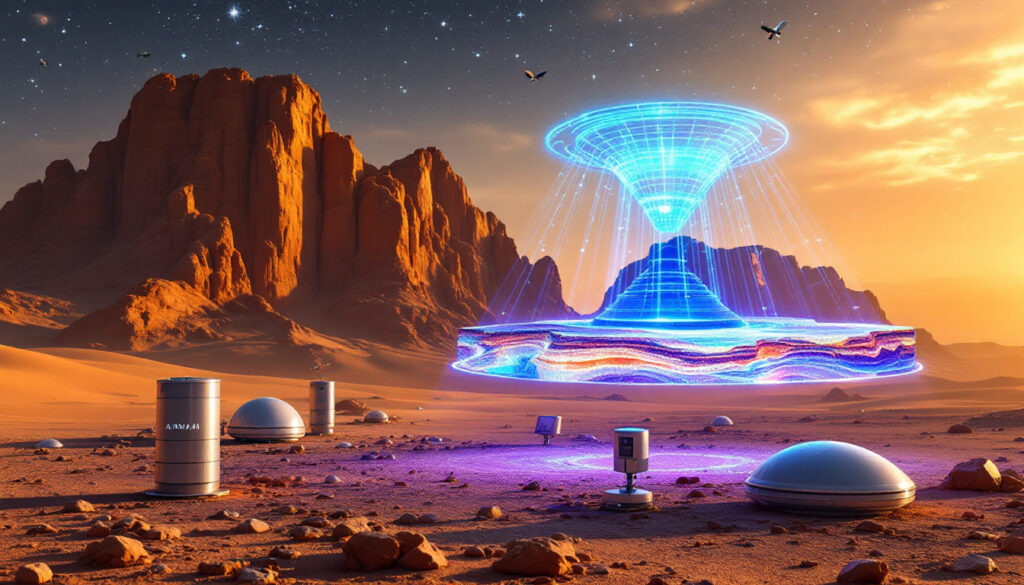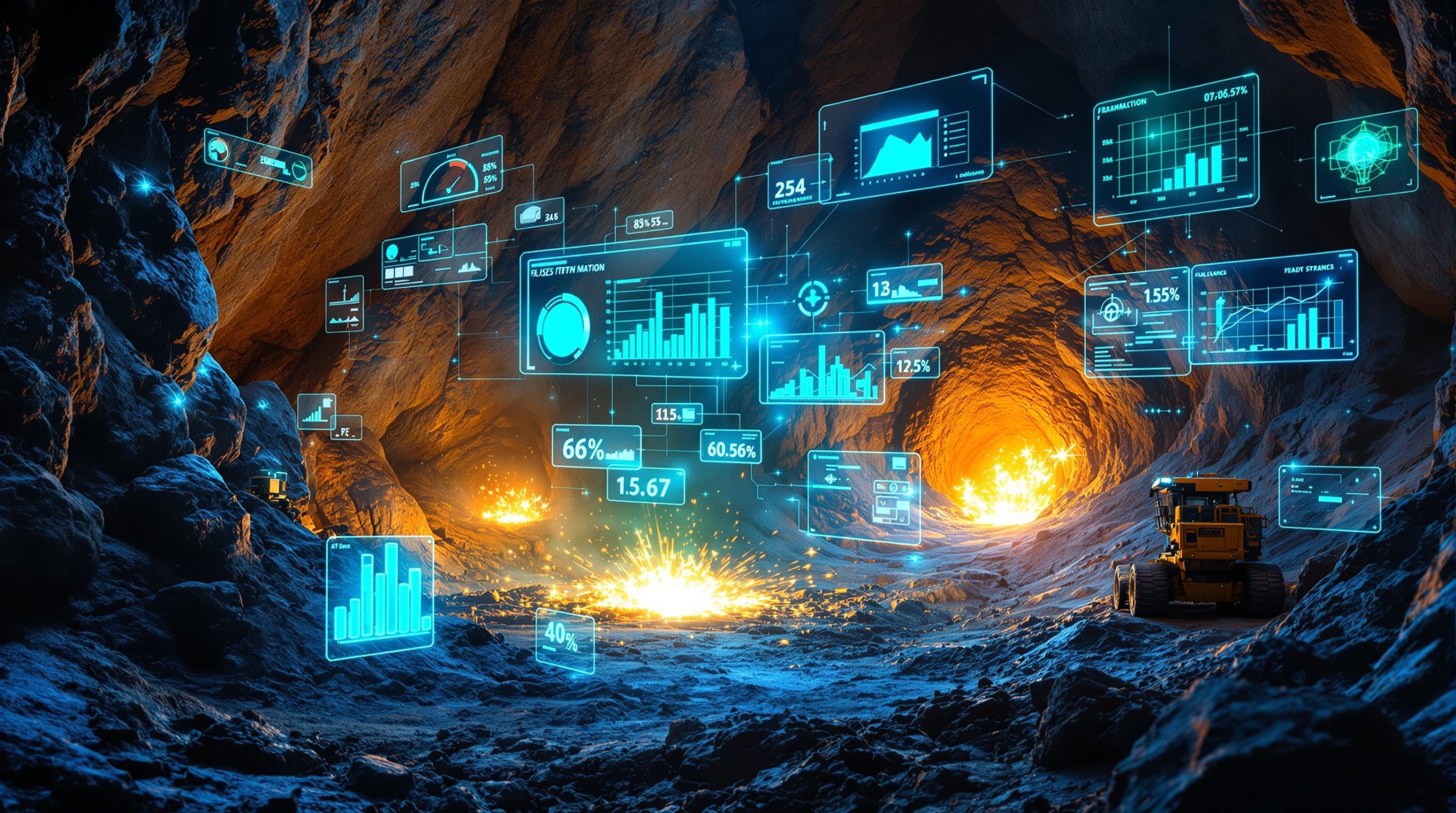How Is Space Technology Transforming Mineral Exploration in Saudi Arabia?
Maaden (Saudi Arabian Mining Co.) has entered into a groundbreaking four-year exploration contract with the Fleet Space & Tahreez Joint Venture. This strategic partnership will deploy advanced space-enabled exploration technology across 12,012.6 km² of Maaden's priority projects throughout the Arabian Shield. The collaboration represents a significant step forward in mineral exploration capabilities, supporting Saudi Arabia's Vision 2030 economic diversification goals and advancing mining digital transformation.
The partnership will implement Fleet Space's flagship ExoSphere technology, enabling high-resolution, real-time 3D subsurface imaging reaching depths of up to 7 km. This comprehensive solution integrates multiple cutting-edge technologies to revolutionize mineral exploration in the region:
- Real-time Ambient Noise Tomography (ANT)
- Advanced active seismic techniques
- Proprietary AI-driven drill targeting systems
- Low Earth orbit (LEO) satellite network integration
- Smart ground sensors for continuous data collection
Maaden's Landmark Exploration Contract with Fleet Space & Tahreez
The four-year exploration contract covers 12,012.6 km² of Maaden's priority projects in the Arabian Shield. This extensive coverage represents one of the largest deployments of satellite-enabled exploration technology in the Middle East mining sector.
ExoSphere technology enables 3D subsurface imaging at depths up to 7 km, providing unprecedented insight into geological formations that were previously difficult to analyze using traditional methods. This capability allows Maaden to identify potential mineral deposits with greater accuracy and significantly less environmental disruption.
Fleet Space's Low Earth Orbit (LEO) satellite network supports real-time data transmission from even the most remote exploration sites, reducing analysis times from months to days and enabling more agile decision-making processes for exploration teams.
As Bob Wilt, CEO of Maaden, explains: "This collaboration integrates space technology, real-time geophysics, and AI to build tomorrow's mineral supply chains" – highlighting the transformative potential of this technological approach to resource discovery.
The ExoSphere Technology Advantage
Ambient Noise Tomography (ANT) represents a revolutionary approach to subsurface mapping, utilizing naturally occurring seismic waves to create detailed 3D models without the need for invasive drilling or explosive seismic sources. This passive technique captures ambient vibrations from earth movements, ocean waves, and even human activity to construct geological maps.
The system's AI-Driven Drill Targeting capabilities employ sophisticated machine learning algorithms that analyze complex geophysical data to identify the most promising drilling locations. By prioritizing high-potential sites, Maaden can reduce unnecessary drilling, saving both resources and minimizing environmental impact through advanced AI in mining operations.
The technology has already proven its effectiveness globally, with companies including Rio Tinto, Barrick, Gold Fields, and AngloGold Ashanti deploying ExoSphere across five continents. These successful implementations validate the system's scalability and effectiveness across diverse geological environments.
Perhaps most impressively, ExoSphere achieves these capabilities while maintaining a near-zero environmental footprint compared to traditional exploration methods, aligning perfectly with Saudi Arabia's Vision 2030 sustainability targets and modern ESG requirements for mining operations.
What Makes This Partnership Strategically Significant?
Advancing Saudi Arabia's Vision 2030
This collaboration directly supports Saudi Arabia's ambitious Vision 2030 initiative by:
- Establishing mining as a potential third pillar of the Saudi economy
- Developing local expertise in advanced mining technologies
- Creating opportunities for Saudi professionals in high-tech exploration
- Accelerating resource discovery to support economic diversification
- Setting new global standards for exploration efficiency and sustainability
The partnership advances Saudi Arabia's Vision 2030 goal to establish mining as the third economic pillar alongside oil and petrochemicals. By deploying cutting-edge exploration technology, Maaden aims to accelerate mineral discovery rates and expand the kingdom's resource portfolio beyond hydrocarbons.
Fleet Space's Middle East expansion follows a recent Memorandum of Understanding with Maaden, signaling a long-term collaborative approach rather than a one-off project. This strategic growth positions Fleet Space as a key technology provider in one of the world's most resource-rich yet underexplored regions, further advancing the mining 4.0 evolution.
As Francesco Fidicaro, Managing Director of Tahreez, notes: "We're equipping Saudi professionals with cutting-edge tools to lead the sector's future" – emphasizing the knowledge transfer component of this partnership and its importance for developing domestic capabilities in advanced exploration techniques.
Expanding Fleet Space's Middle East Presence
The contract marks a significant expansion of Fleet Space Technologies' operational footprint in the Middle East, following a recently signed MOU between the parties. This strategic growth positions Fleet Space as a key technology provider in one of the world's most resource-rich regions.
A key aspect of this partnership is Local Workforce Development, with Tahreez's joint venture focusing specifically on knowledge transfer initiatives. The program aims to train Saudi geoscientists and engineers in the application of space technologies for resource exploration, building domestic expertise that will benefit the kingdom long after the initial exploration contract concludes.
This approach creates a virtuous cycle: as local expertise grows, exploration efficiency improves, leading to more discoveries which further justify investment in talent development. The model has proven successful in other mining jurisdictions like Australia and Chile, where domestic technical capabilities have become exportable services in their own right.
How Does ExoSphere Transform Traditional Exploration Methods?
Real-Time Data Revolution
The ExoSphere platform represents a paradigm shift in mineral exploration through:
- Satellite-Enabled Connectivity: Continuous data transmission from remote field locations
- AI-Enhanced Analysis: Advanced algorithms that identify potential mineral deposits
- Rapid Deployment Capabilities: Field teams receive 3D subsurface insights within days rather than months
- Minimal Environmental Impact: Near-zero environmental footprint compared to traditional methods
- Scalable Operations: Technology that can be deployed across vast exploration territories
ExoSphere reduces exploration timelines from months to days, transforming what has traditionally been a slow, methodical process into a dynamic, data-driven operation. This acceleration doesn't come at the cost of accuracy – in fact, the integration of HiSeis' active seismic solutions enhances imaging accuracy by approximately 30% compared to standalone methods.
Flavia Tata Nardini, CEO of Fleet Space, emphasizes this transformative potential: "Connecting passive and active seismic methods revolutionizes subsurface validation" – highlighting how the combination of different techniques creates a more comprehensive and reliable picture of what lies beneath the surface.
One of the most forward-looking aspects of the technology is the SPIDER Lunar Deployment scheduled for 2026. This Moon variant of ExoSphere will map lunar subsurface resources, demonstrating the platform's versatility and potential applications beyond Earth-based exploration.
Integration of Active Seismic Solutions
Following Fleet Space's acquisition of HiSeis, the world's leading provider of active seismic solutions, the ExoSphere platform now offers:
- Comprehensive integration of passive and active seismic techniques
- Enhanced subsurface imaging accuracy and resolution
- Multi-method validation of potential mineral deposits
- More precise drill targeting to reduce exploration costs
- Faster progression from discovery to development
This integration has already shown impressive results in field deployments. In South Africa, for example, ExoSphere identified gold deposits at 5 km depth with approximately 90% accuracy for Gold Fields – a level of precision that would have been nearly impossible with conventional methods alone.
The system's multi-method approach provides built-in validation, with passive and active seismic data offering complementary perspectives on subsurface structures. This redundancy not only improves confidence in the results but also helps prioritize targets based on their correlation across different sensing modalities, similar to how digital twins in mining create comprehensive operational models.
Who Are the Key Players in This Transformative Partnership?
Maaden's Strategic Vision
Under CEO Bob Wilt's leadership, Maaden is positioning itself at the forefront of technology-driven mineral exploration:
"This exploration contract with the Fleet Space & Tahreez JV marks the beginning of a new chapter in the future of mineral exploration – one where the latest advances in space technology, real-time geophysics, and AI converge to build the mineral supply chains of tomorrow."
The company aims to establish new global benchmarks in exploration data intelligence while creating more efficient and sustainable pathways for the mining sector.
Maaden, Saudi Arabia's mining champion, contributes approximately $46B annually to GDP and plays a critical role in the kingdom's economic diversification strategy. Under Bob Wilt's leadership, the company has increasingly embraced technological innovation to drive growth and sustainability.
Wilt has stated that "Maaden aims to set global benchmarks in exploration intelligence" – highlighting the company's ambition to not just adopt cutting-edge technology, but to help define industry best practices through this partnership.
Fleet Space Technologies' Innovative Approach
Co-founded by CEO Flavia Tata Nardini, Fleet Space Technologies is driving a fundamental transformation in how exploration data is collected, analyzed, and utilized:
"Space-enabled, real-time exploration is unlocking unprecedented speed, reach, and data quality – transforming mineral discovery into a dynamic, data intelligence-led system."
The company's technology has already been adopted by global mining leaders including Rio Tinto, Barrick, Gold Fields, and AngloGold Ashanti across five continents.
Fleet Space secured $100M Series D funding in 2023 to scale ExoSphere technology globally, according to Fleet Space's announcement. This substantial investment has enabled the company to expand both its satellite constellation and its ground-based sensing technologies.
A key strategic move was the HiSeis Acquisition in 2023, which integrated active seismic expertise into the ExoSphere platform. This acquisition allowed Fleet Space to offer a more comprehensive solution that combines both passive and active sensing methods, significantly enhancing the system's capabilities.
Tahreez's Focus on Local Capability Development
Francesco Fidicaro, Managing Director of Tahreez, emphasizes the importance of knowledge transfer and skills development:
"By embedding cutting-edge, space-enabled technologies into the heart of Saudi exploration, we're also building something far more powerful: a generation of Saudi men and women equipped with the skills, mindset, and tools to lead this sector into the future."
Tahreez brings valuable regional expertise and a focus on developing local capabilities to the joint venture. The company specializes in technology transfer and adaptation to Middle Eastern operational environments, ensuring that advanced exploration techniques can be effectively deployed in Saudi Arabia's unique geological and logistical context.
What Are the Broader Implications for the Mining Industry?
Setting New Industry Standards
This partnership establishes new benchmarks for the global mining sector in several key areas:
- Data-Driven Decision Making: Shifting from intuition-based to evidence-based exploration
- Exploration Efficiency: Dramatically reducing time from target identification to drilling
- Environmental Stewardship: Minimizing surface disturbance during exploration phases
- Resource Optimization: More precise targeting leading to better resource utilization
- Technology Integration: Seamless connection between space, field, and laboratory operations
ExoSphere's 99% data accuracy reduces costly dry wells by approximately 50%, representing a significant improvement in exploration economics. This level of precision changes the fundamental calculus of mineral exploration, allowing companies to pursue targets that might previously have been considered too risky or marginal.
The system's ability to rapidly assess large areas also enables more comprehensive exploration strategies. Rather than focusing on a few promising locations, companies can now evaluate entire regions efficiently, potentially uncovering deposits that might have been overlooked by more selective approaches.
Future Applications Beyond Earth
The technology being deployed in Saudi Arabia has applications that extend beyond terrestrial mining:
- Fleet Space will deploy SPIDER, a lunar variant of ExoSphere technology, on the Moon in 2026
- This deployment will inform future lunar mission planning through detailed subsurface mapping
- The technology demonstrates potential applications for resource exploration on other planetary bodies
The SPIDER lunar mission scheduled for 2026 could pioneer off-world mining techniques by the end of this decade. While initially focused on scientific exploration, the technology has clear applications for identifying resources that could support sustained human presence on the Moon.
The Multi-Planetary Applications of this technology extend beyond lunar exploration. The techniques being refined in Saudi Arabia's deserts may eventually inform Mars resource mapping for future colonies, demonstrating how terrestrial innovation can enable humanity's expansion into the solar system.
How Does This Contract Support Sustainability Goals?
Environmental Impact Reduction
The ExoSphere technology offers significant environmental advantages:
- Minimal surface disturbance compared to traditional exploration methods
- Reduced need for extensive road building and clearing in remote areas
- Lower carbon footprint through optimized field operations
- More precise targeting resulting in fewer exploratory drill holes
- Enhanced ability to avoid environmentally sensitive areas
ExoSphere reduces surface disturbance by approximately 70% versus traditional methods that often require extensive clearing for access roads, drill pads, and support infrastructure. This dramatic reduction helps preserve natural habitats and reduces the visual impact of exploration activities.
The system's precision also means that 30% fewer drill holes are needed to evaluate a target area. Since drilling represents one of the most invasive and resource-intensive aspects of mineral exploration, this reduction has significant environmental benefits while also lowering project costs.
Supporting ESG Objectives
The partnership aligns with modern ESG (Environmental, Social, Governance) priorities by:
- Advancing sustainable exploration practices
- Developing local technical capabilities and expertise
- Creating high-skilled employment opportunities
- Improving resource discovery efficiency
- Reducing waste through more targeted exploration
As Francesco Fidicaro notes: "Sustainable exploration aligns with Saudi Arabia's green transition" – highlighting how modern mining approaches can support rather than conflict with environmental goals.
The partnership's emphasis on Carbon Footprint Analytics means that Fleet Space's sensors can track and report emissions throughout the exploration process. This data-driven approach to sustainability allows for continuous improvement and transparent reporting on environmental performance.
By combining environmental benefits with social development through knowledge transfer and governance improvements via data-driven decision making, the partnership addresses all three pillars of ESG simultaneously – a rare achievement in resource sector projects.
What Financial and Technological Developments Support This Initiative?
Recent Corporate Milestones
Several key developments have positioned Fleet Space for this major contract:
- Completion of a USD$100 million Series D funding round
- Strategic acquisition of HiSeis, the world's leading provider of active seismic solutions
- Integration of multiple geophysical techniques into a unified exploration platform
- Expansion of satellite constellation capabilities
- Development of advanced AI models for subsurface interpretation
The $100M Series D Funding secured in 2023 has accelerated ExoSphere's R&D and global deployments, allowing Fleet Space to scale its operations to meet the demands of major mining companies. This substantial investment reflects growing confidence in space-enabled exploration technologies.
The HiSeis Integration, estimated to have cost around $20M, has significantly enhanced the platform's seismic capabilities. This strategic acquisition brought world-leading expertise in active seismic techniques under Fleet Space's umbrella, enabling a more comprehensive approach to subsurface imaging.
Technology Integration Achievements
The ExoSphere platform represents a significant achievement in technology integration:
- Connecting multiple geophysical techniques with satellite connectivity
- Real-time processing of complex subsurface datasets
- AI-driven interpretation of geological structures
- Seamless data flow from field sensors to decision-makers
- Continuous improvement through machine learning algorithms
Fleet Space's LEO Satellite Constellation now includes approximately 120 satellites that provide global coverage with 15-minute latency for data transmission. This extensive network ensures that even the most remote exploration sites can benefit from real-time data analytics.
The platform's integration capabilities extend beyond hardware to include sophisticated software systems that combine data from multiple sources into coherent 3D models. These models are continuously refined as new data becomes available, creating an ever-more-accurate picture of subsurface structures and mineral deposits, similar to how virtual reality in mining creates immersive visualization experiences.
Comparative Analysis: Space-Enabled vs. Traditional Exploration
| Aspect | Traditional Exploration | Space-Enabled Exploration |
|---|---|---|
| Data Collection Time | Weeks to months | Hours to days |
| Exploration Depth | Typically 1-2 km | Up to 7 km |
| Environmental Footprint | Significant surface disturbance | Near-zero impact |
| Data Processing | Manual interpretation | AI-enhanced analysis |
| Coverage Area | Limited by physical access | Extensive coverage possible |
| Real-Time Capabilities | Limited or none | Continuous data streaming |
| Decision-Making Speed | Weeks between data and decisions | Days or hours |
| Integration Capabilities | Siloed data sources | Unified data platform |
| Scalability | Resource-intensive to scale | Rapidly deployable at scale |
FAQ: Understanding the Maaden-
Ready to Identify the Next Major Mining Discovery?
Stay ahead of the market with Discovery Alert's proprietary Discovery IQ model, delivering instant notifications of significant ASX mineral discoveries and turning complex data into actionable insights. Explore historic returns from major discoveries and begin your 30-day free trial today at Discovery Alert's discoveries page.




